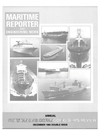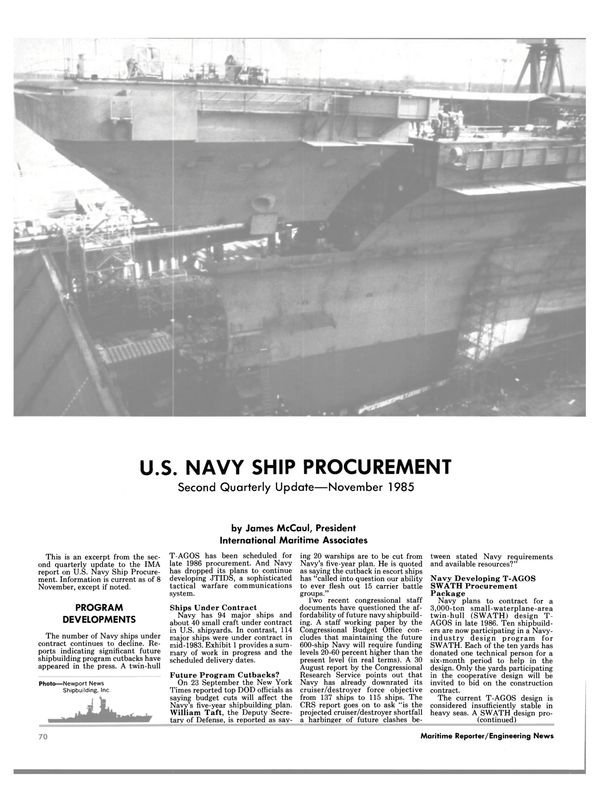
U.S. NAVY SHIP PROCUREMENT Second Quarterly Update—November 1985
This is an excerpt from the second quarterly update to the IMA report on U.S. Navy Ship Procurement.
Information is current as of 8 November, except if noted.
PROGRAM DEVELOPMENTS The number of Navy ships under contract continues to decline. Reports indicating significant future shipbuilding program cutbacks have appeared in the press. A twin-hull T-AGOS has been scheduled for late 1986 procurement. And Navy has dropped its plans to continue developing -JTIDS, a sophisticated tactical warfare communications system.
Ships Under Contract Navy has 94 major ships and about 40 small craft under contract in U.S. shipyards. In contrast, 114 major ships were under contract in mid-1983. Exhibit 1 provides a summary of work in progress and the scheduled delivery dates.
Future Program Cutbacks?
On 23 September the New York Times reported top DOD officials as saying budget cuts will affect the Navy's five-year shipbuilding plan.
Wiliiam Taft, the Deputy Secretary of Defense, is reportedjis^saying 20 warships are to be cut from Navy's five-year plan. He is quoted as saying the cutback in escort ships has "called into question our ability to ever flesh out 15 carrier battle groups." Two recent congressional staff documents have questioned the affordability of future navy shipbuilding.
A staff working paper by the Congressional Budget Office concludes that maintaining the future 600-ship Navy will require funding levels 20-60 percent higher than the present level (in real terms). A 30 August report by the Congressional Research Service points out that Navy has already downrated its cruiser/destroyer force objective from 137 ships to 115 ships. The CRS report goes on to ask "is the projected cruiser/destroyer shortfall a harbinger of future clashes between stated Navy requirements and available resources?" Navy Developing T-AGOS SWATH Procurement Package Navy plans to contract for a 3,000-ton small-waterplane-area twin-hull (SWATH) design TAGOS in late 1986. Ten shipbuilders are now participating in a Navyindustry design program for SWATH. Each of the ten yards has donated one technical person for a six-month period to help in the design. Only the yards participating in the cooperative design will be invited to bid on the construction contract.
The current T-AGOS design is considered insufficiently stable in heavy seas. A SWATH design pro- vides a relatively stable platform in most sea conditions.
It is uncertain whether the ship construction contract will be funded from FY 1986 or FY 1987 SCN funds. Navy wants to use FY 1986 T-AGOS funds for the SWATH procurement. This would require approval of Congress—and at time of publication the Senate, but not the House, favors such approval.
FY 1987 funds would be used if the request to use FY 1986 funds is denied. Presumably the SWATH T-AGOS would be procured using funds originally programmed for the option ships in the Halter T-AGOS contract.
Navy JTIDS Dropped Navy has cancelled plans to develop its own version of a joint tactical information distribution system (JTIDS). Navy still plans to install JTIDS, a jam-resistant voice and data communications system, on board ships, aircraft and in groundbased command centers. But the system will be that under development by the Air Force at Rockwell- Collins and Singer Kearfott.
The proposed FY 1986 Navy program had included $185 million to continue Navy JTIDS development efforts in progress at ITT and Hughes Aircraft. In the authorization process Congress refused to authorize separate, parallel JTIDS development by Navy and Air Force.
DOD was directed to review the current Navy and Air Force JTIDS programs—and choose one for use by both services. The Air Force system apparently was considered the cost effective alternative.
FY 1985 CONTRACT WRAP-UP Navy contracts exceeding $33 billion were awarded to 372 companies in FY 1985. Seventy-two percent of the value of these contracts were awarded to the 20 largest contractors.
Top Navy Contractors Navy awarded in FY 1985 about 1,500 large contracts (i.e., contracts exceeding $3 million). A listing of the top 100 contractors and their reported Navy contract value is provided in Exhibit 2. The 50 largest individual contracts during FY 1985 are listed in Exhibit 3.
Shipbuilding Contractors General Dynamics and Newport News head the list of shipbuilding contractors in FY 1985 as a result of continued submarine construction.
GD received a $616-million contract for a Trident submarine and a $283- million contract for an attack submarine.
Newport News received a $780-million contract for three attack submarines. Bath was third in contract value—with a $322-million contract for the lead DDG-51 and a $384-million contract for two Aegis cruisers. Avondale placed fourth with contracts to build three TAO fleet oilers and two LSD amphibious landing ships. In fifth place is Litton-Ingalls who received a contract to build one Aegis cruiser and provide lead yard services for the Aegis cruiser program. The list of shipbuilding contractors is shown in Exhibit 4.
Ship Ordnance and Electronics Contractors General Dynamics heads the ship ordnance and electronics list for FY 1985. The firm's Pomona Division received more than $580 million in contracts for the close-in weapon system (CIWS) and $570 million in contracts for the Standard missile.
GD's Convair Division last year received contracts exceeding $380 million for Tomahawk cruise missiles.
Lockheed, sole supplier of the Trident ballistic missile, was second on the list. Last year the firm received Trident missile contracts exceeding $1.2 billion. Raytheon was the third largest ship ordnance and electronics supplier. Major contracts were received for Aegis fire control systems, sonar systems and electronic countermeasure systems. RCA is fourth—based on contracts exceeding $480 million to supply the Aegis weapon system. In fifth place is McDonnell Douglas, who (along with GD-Convair) supplies the Tomahawk cruise missile. The list of ship ordnance and electronics contractors is provided in Exhibit 5.
Ship Machinery General Electric and Westinghouse are the major machinery sup- pliers. Both firms manufacture nuclear power plants for Navy. The Knolls Atomic Power Laboratory and Machinery Apparatus Operation of G.E. received naval nuclear plant contracts exceeding $540 million.
Westinghouse's Bettis Power Laboratory and its Plant Apparatus Division received more than $490 million in naval nuclear plant contracts.
Other than nuclear power plants, most machinery is supplied as contractor furnished material.
Exhibit 6 lists ship machinery prime contractors.
Engineering and Design Services The Charles Stark Draper Laboratory heads the list with Navy contracts exceeding $270 million to design a guidance system for the Trident missile. TRW is second with contracts exceeding $75 million for advanced electronics development and $24 million for support services to the amphibious ship program office.
Vitro is third with contracts exceeding $40 million to provide support services to the Trident missile program. Sperry is fourth based on its contracts to provide engineering field services for patrol craft, frigates and logistics assistance. General Dynamics and Newport News are fifth and sixth due to their design work on the SSN-21. A list of engineering and design contractors is provided in Exhibit 7.
Ship Chartering and Operation Marine Transport is the obvious leader in this area for FY 1985— with a $187-million contract to operate and maintain nine MSC sealift tankers and an $80-million contract to operate 12 MSC oceanographic ships. Sea Mobility is second with a $42-million contract to operate and maintain 12 T-AGOS ocean surveillance ships. Vessel Charters is third with its contract to charter a ship to the MSC. Fourth on the list is Bay Tankers, who received a contract to operate and maintain four T-AKR sealift ships. A list of contractors is provided in Exhibit 8.
Read U.S. NAVY SHIP PROCUREMENT Second Quarterly Update—November 1985 in Pdf, Flash or Html5 edition of December 1985 Maritime Reporter
Other stories from December 1985 issue
Content
- United States Cruises Applies To M a r A d For $150-Million Title XI page: 4
- PA Series Heavy Fuel Diesel Now Available From Fairbanks Morse page: 6
- Six-Page Color Brochure On Energol Lubricants Offered Free By BP Marine page: 6
- Getty Fleet Orders Lips Speed-Adapted Propellers To Increase Efficiency page: 6
- Karl Senner Offers Free Color Brochure On Reintjes Marine Gearboxes page: 6
- OMSA Elects New Officers —Congressman Warns Of California Plan' page: 8
- Birka Line Cruise Ship Launched At Valmet's Helsinki Shipyard page: 8
- Fire Combat, Inc. Offers 10-Page Manual On Fire Suppression Systems page: 9
- Texaco Appoints Quegan General Manager, Marine Department page: 10
- Fernstrom Elected President And CEO Of American Ship Building page: 10
- New Briefcase Computer For Marine Industry From NAV-COM page: 12
- Furuno USA Introduces New Doppler Speed Log And ARPA Line page: 12
- W. Anthony Watt Heads Sales And Marketing Division At Moran Towing page: 14
- Marinette Delivers First Of Ten Torpedo Weapons Retrievers page: 14
- Bassett Named President Of Interocean Management page: 14
- Kockums To Build Ferry With First Coal-Fired Marine Steam Engines In 30 Years page: 16
- COSCO And McMullen Form New Company— COSCO North America page: 17
- Cunard Gives $115-Million Contract To Lloyd Werft To Convert QE2 To Diesel And Alter Accommodations page: 17
- Harnischfeger To Build World's Largest Dipper/Clamshell Dredge page: 18
- Bethlehem Steel Dedicates Its New Sabine Yard In Port Arthur, Texas page: 18
- Totem To Acquire Controlling Interest In Interocean Steamship Corp. page: 20
- OUTSTANDING OCEANGOING SHIPS OF 1985 page: 22
- NOTABLE CONVERSIONS OF 1985 page: 44
- Bender Shipbuilding Wins $4.5 Million In Contracts page: 49
- Construction of 'Theodore Roosevelt' Ahead Of Schedule And Under Budget page: 50
- Magnavox Introduces New Generation SatCom And New GPS/Transit SatNav Receivers page: 51
- GPS/Transit SatNav Receivers page: 52
- Network 90, Integrated Marine Management System For Reduced Costs And Maximized Profits page: 55
- SHIPBOARD COMPUTER SURVEY page: 58
- Ellicott Machine Corporation Announces Personnel Changes page: 68
- Vapor Corporation Announces New Sphere Matrix Technology page: 68
- U.S. NAVY SHIP PROCUREMENT Second Quarterly Update—November 1985 page: 70
- MSI Conducting Tests For Proposed Canadian Ferry With Voith Schneider Propulsion page: 77
- Design Improvements In EMD's 645FB Diesel Provide Higher Horsepower, Better Fuel Economy page: 78
- Perko Presents The 200 Series International Navigation Lights page: 81
- Coast Guard Completes Installation Of Advanced Navigational Aid In N.Y. Harbor page: 85
- Macmeter Offers Metering Protection page: 91
- MARDATA Named North American Agent For Lloyd's Information Services page: 91


